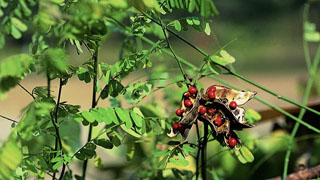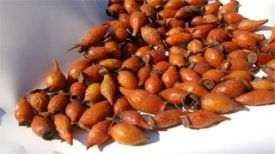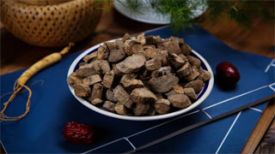
Nicknames: Red Bean, Yunnan Bean, Langjunzi, Red Lacquer Bean, Acacia Bean, Chicken Mother Pearl, Nandan Zhenzhu, Bazhongshan Coral, Beauty Bean, Guanyinzi, Guiyanzi, Mandarin Duck Bean, Earth Licorice Bean, Langjun Bean, Blackhead Chick
Harvesting and processing: Mature fruits are harvested in batches in summer and autumn, dried, seeded, and impurities removed.
Medicinal parts: Mature seeds
Origin: Fujian, Taiwan, Guangdong, Hainan, Guangxi, Yunnan, etc
Family: Leguminosae
Original plant: Acacia seed
Plant condition: Climbing shrubs
The branches are thin and weak, with flat short bristles.
Even feathered compound leaves, alternate, with 8-15 pairs of small leaves, short stalks, oblong in shape, rounded at both ends, with a very small pointed tip at the tip, measuring 1-2cm in length and 0.3-0.3cm in width, with no hairs on top and sparse fine hairs on the bottom.
The inflorescence is very small, 3-6 cm long, head shaped, grows on short branches, without a total peduncle, the inflorescence axis is short and thick, and fleshy. Small flowers, tightly arranged, about 9mm long, with short stems; Calyx is yellow green, bell shaped, about 3mm long, with 4 short teeth at the tip, and hairy on the outer side; The corolla is light purple, the flag petal is wide ovate, with triangular claws at the base, and the wing and keel petals are narrow; Stamens 9, forming a bundle; Ovary superior, hairy, style hairless, stigma with fine papillae.
The pod is yellow green, leathery, diamond shaped oblong, flat or swollen, measuring 2-4.5cm in length and 1.2-1.4cm in width. It has a curved beak at the tip and is covered with fine hairs resembling rigid hairs. 4-6 seeds, oval in shape, black at one end of the navel, vermilion at the upper end, 6.5mm long, glossy. The flowering period is from March to May, and the fruiting period is from September to October.
Characteristics of Acacia Seed Medicinal Materials: The dried seeds are elliptical in shape, with a few nearly spherical in shape, with a length of 5-7 millimeters and a short diameter of 4-5 millimeters. The surface is red, and the navel is white elliptical, located at one end of the ventral surface, with a dark black color around it, accounting for about 1/4 to 1/3 of the surface of the seed coat. The ridge is located at one end of the navel and is slightly convex in a straight line shape. The seed coat is hard and not easily broken, with two cotyledons and embryonic roots inside, both of which are light yellow in color. Qi green grass like, astringent taste
High quality products are best if they are large, with a red head, black background, bright color, round grains, and full.
The medicinal properties of lovebirds:
[Taste] Hard work; Flat; Toxic
[Returning to the Classic] Heart; Lung meridian
【 Indications and Functions 】 Clearing heat and detoxifying, reducing phlegm, and killing insects. Main pain sores, mumps, scabies, rheumatism, and bone pain
【 Usage and Dosage 】 For external use: appropriate amount, apply without adjustment; Or boil and wash with water; Or apply ointment.
[Caution] Not suitable for oral administration to prevent poisoning.
【 Compound 】 Treating malaria, cold and heat: Fourteen Acacia seeds. Water research suit, take and vomit. (Gan Jin Fang)
【 Discussions from Various Schools 】
1. "Compendium of Materia Medica Collection": It can unblock the nine orifices and treat the heart and abdomen qi. Relieve fever, stuffiness, headache, and wind phlegm. Kill all insects in the abdomen and skin.
2. "Modern Practical Traditional Chinese Medicine": Used for treating skin diseases such as scabies and stubborn ringworm, as an infusion or paste. "
Compound: Treating malaria, cold and heat: Fourteen Acacia seeds. Water research suit, take and vomit. (From "Qian Jin Fang")


